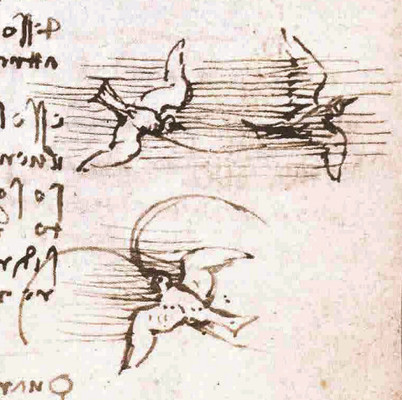You’ve probably heard of Leonardo’s pioneering "flying machine" designs made 400 years before the Wright Brothers’ first flight – pretty impressive. Focusing on friction and resistance, Leonardo hoped that one day he could teach us all to fly like birds, but he quickly realized that human strength alone could not lift us from the ground. So, he began to look at birds’ wings and other types of wings that might one day make a flying machine. His visions of flight were his most ambitious, fundamentally challenging what people at the time dreamed was possible. Examining motion through air, Leonardo studied the flight of birds to understand how their delicate structures were able to resist the force of gravity, and to soar high in the sky.

He spent years recording the movements of birds. He understood that birds’ flapping wings made them fly. He knew that air passing over their wings created lift. In 1485, Leonardo designed a wing-flapping aircraft called an ornithopter. It relied on human strength for power. But since Leonardo never actually built his ornithopter, he didn’t realise it was too heavy to work.
Activities
PART 2
Prepare a common Genial.ly with the main information about flying machines, answer the questions from point 2 – use pins to make your presentation more interactive.
HISTORIANS
1. Leonardo da Vinci's flying machine and other inventions connecting with flying. What kinds of flying machines did da Vinci come up with?
a) Winged flying machine (the aeroplane),
b) Helical aerial screw (the helicopter),
c) Glider,
d) Parachute,
e) Other flying machines
2. Answer the questions:
a) How did Leonardo da Vinci explore flight?
b) Why did Leonardo da Vinci think his ornithopter would work?
c) Leonardo and the fluid-dynamics
d) Why did Leonardo da Vinci study birds? - Codex on the Flight of Birds
BIOLOGISTS
You will have to find information flying in nature. How do birds fly? What helps a bird to fly? What three things help a bird to fly? Flying seeds and leaves – examples. How do feathers help birds fly?
Take into consideration:
a) Wings
b) Gliding
c) Soaring
d) Flapping
e) Obtaining thrust
PHYSICISTS
-
How do things fly? What makes an airplane fly?
-
What are the 4 principles of flight?
-
How does the Bernoulli Principle relate to airplane flight?
-
Do at least 3 experiments per country showing Bernoulli's principle and prepare films with the explanations - local activity - prepare a film showing your experiments.
-
Vocabulary in different languages/Definitions in EnglishAerodynamics, Acceleration, Drag, Force, Lift, Thrust, Weight
PART 3
Welcome young scientists and engineers!
You have been invited to participate in an important science and engineering project.
Your mission:
Build scientific instruments called anemometers for measuring wind speed and analyze wind speed data.
You have to complete questions 1-3 in international groups, discuss with your team, and share out responses. Then, add to your original responses in a different colour after discussion and research to show new ideas gained.
LINK with the anemometers
After completing the file the coordinators will add your ideas to a common mind map:
RESULTS
Task 1
LINK TO WIND MIND MAP
Collaborative activity:
GROUP A
GROUP B